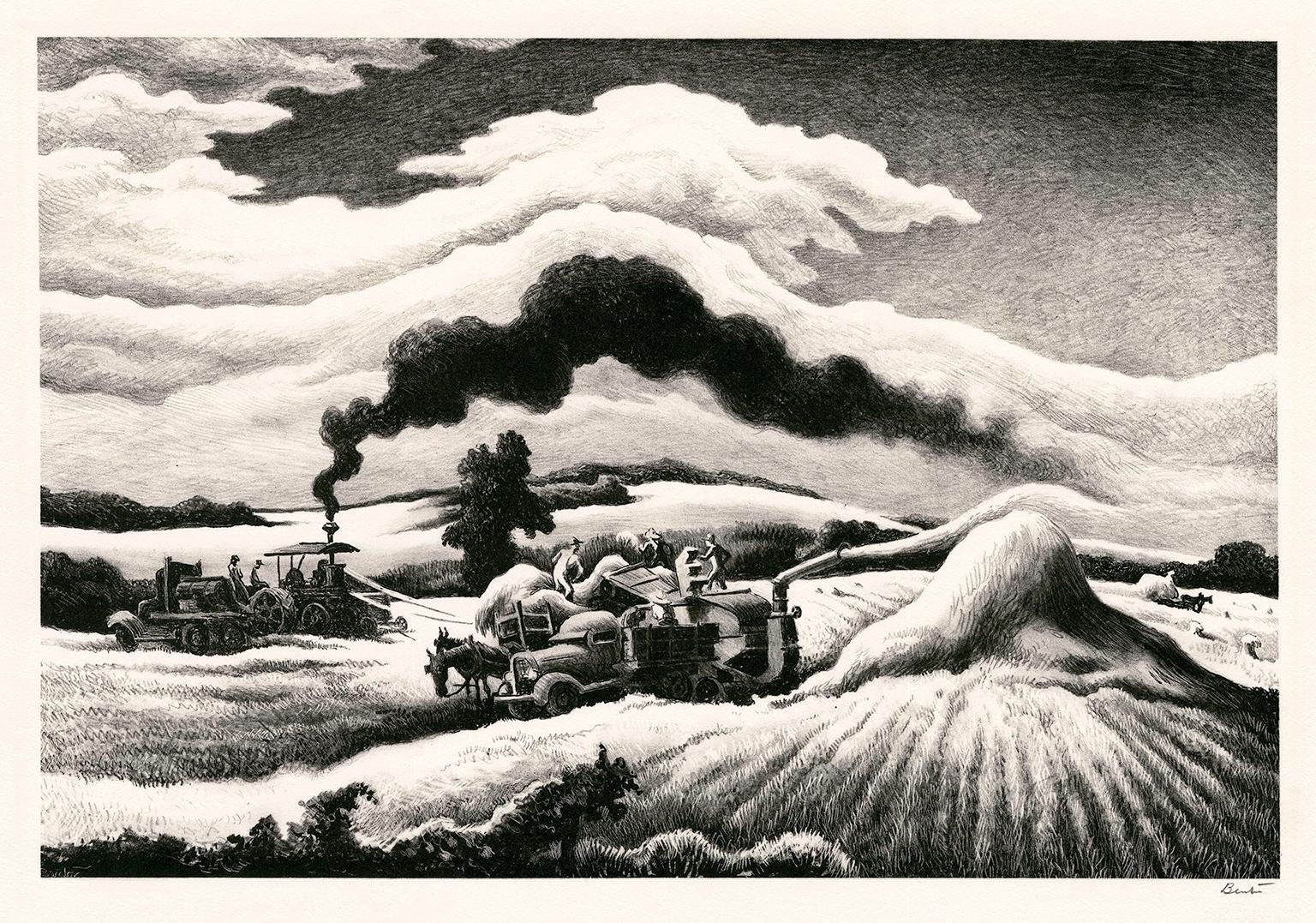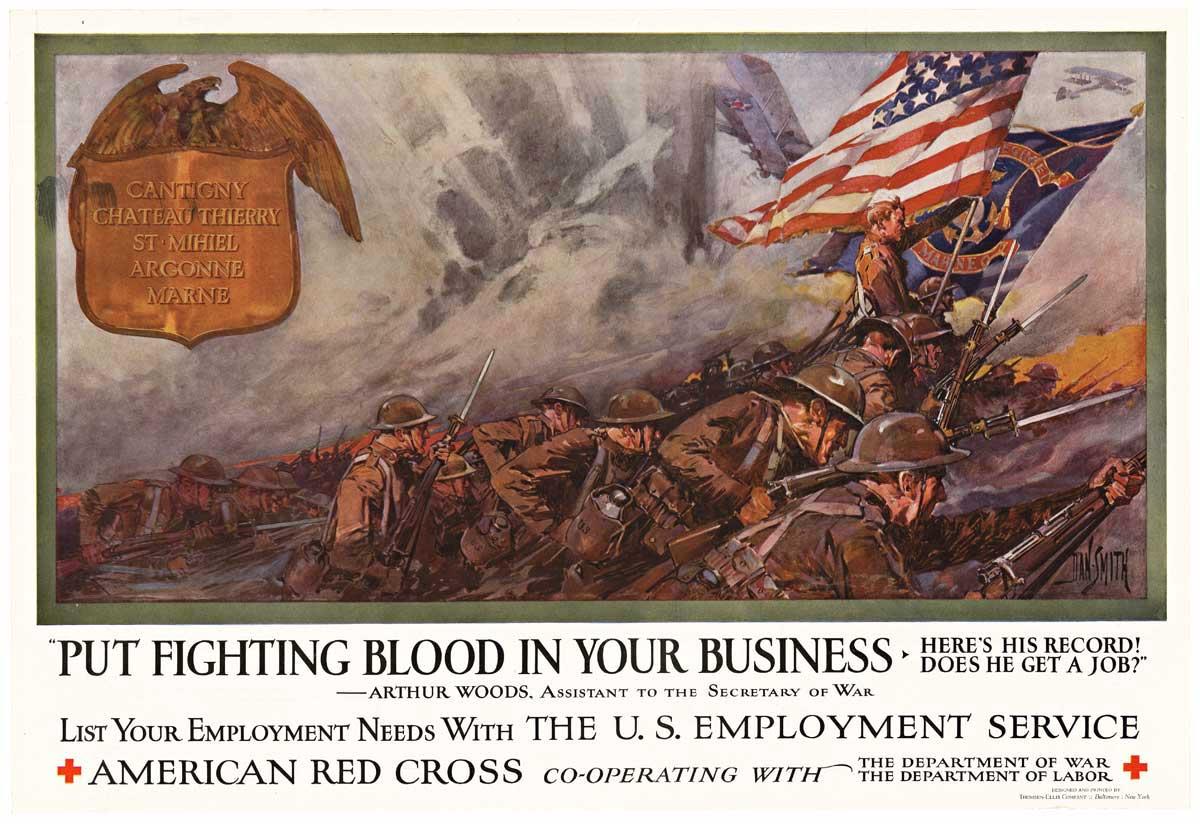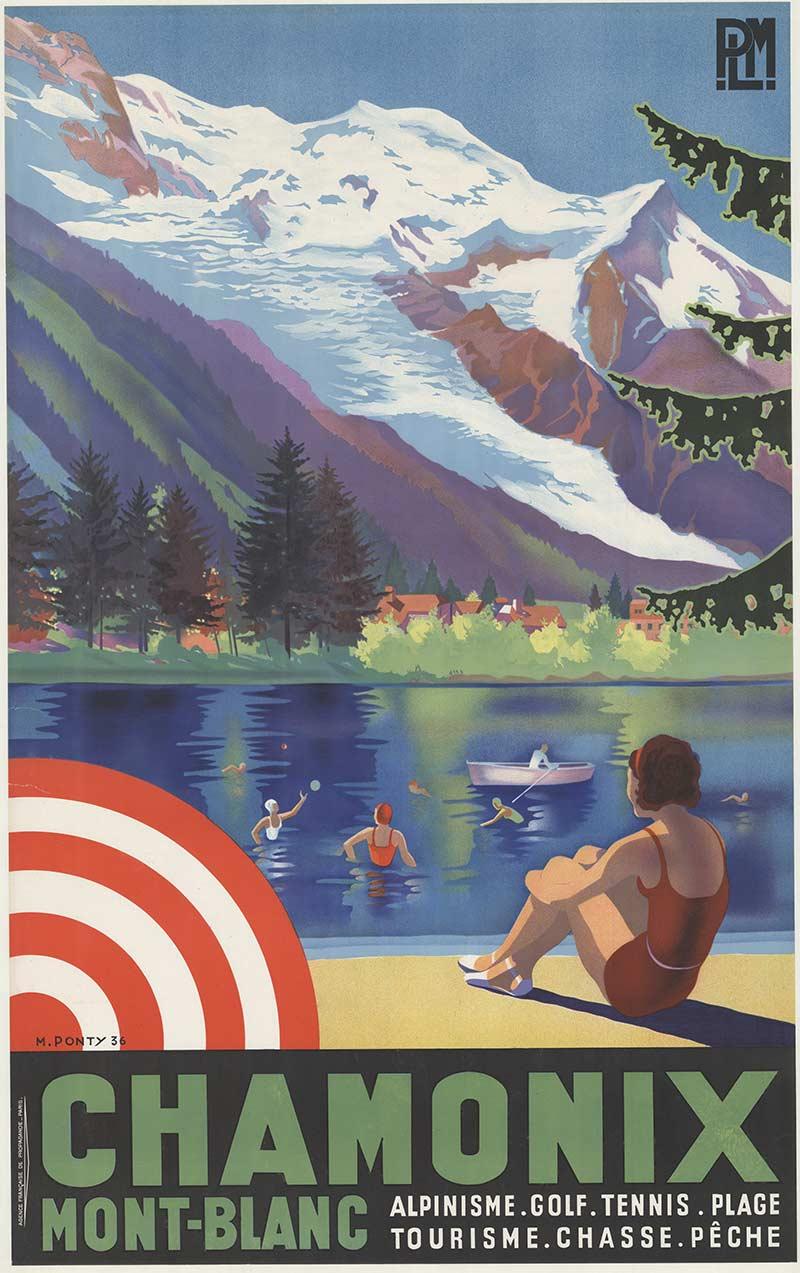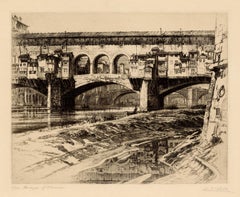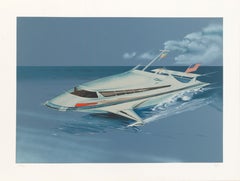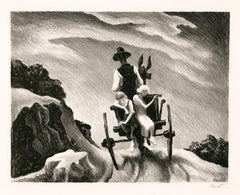
'Goin' Home' — 1930s American Regionalism
View Similar Items
Want more images or videos?
Request additional images or videos from the seller
1 of 3
Thomas Hart Benton'Goin' Home' — 1930s American Regionalism1937
1937
About the Item
- Creator:Thomas Hart Benton (1889-1975, American)
- Creation Year:1937
- Dimensions:Height: 9.44 in (23.98 cm)Width: 11.88 in (30.18 cm)
- Medium:
- Movement & Style:
- Period:
- Condition:
- Gallery Location:Myrtle Beach, SC
- Reference Number:Seller: 1040881stDibs: LU532310364772
About the Seller
5.0
Recognized Seller
These prestigious sellers are industry leaders and represent the highest echelon for item quality and design.
Platinum Seller
These expertly vetted sellers are 1stDibs' most experienced sellers and are rated highest by our customers.
Established in 1995
1stDibs seller since 2016
Typical response time: 2 hours
Associations
International Fine Print Dealers Association
More From This SellerView All
- 'Threshing' — 1940s American RegionalismBy Thomas Hart BentonLocated in Myrtle Beach, SCThomas Hart Benton, 'Threshing', lithograph, 1941, edition 250, Fath 48. Signed in pencil. Signed in the stone, lower left. A fine, richly-inked impression, on off-white, wove paper, with full margins (1 3/8 to 1 5/8 inches), in excellent condition. Published by Associated American Artists. Image size 9 5/16 x 13 13/16 inches (237 x 351 mm); sheet size 12 1/2 x 16 5/8 inches (318 x 422 mm). Archivally matted to museum standards, unframed. Impressions of this work are held in the following museum collections: Art Institute of Chicago, Fine Arts Museums of San Francisco, High Museum of Art, McNay Art Museum, Montgomery Museum of Fine Arts, and Nelson-Atkins Museum of Art. ABOUT THE ARTIST “Benton’s idiom was essentially political and rhetorical, the painterly equivalent of the country stump speeches that were a Benton family tradition. The artist vividly recalled accompanying his father, Maecenas E. Benton — a four-term U.S. congressman, on campaigns through rural Missouri. Young Tom Benton grew up with an instinct for constituencies that led him to assess art on the basis of its audience appeal. His own art, after the experiments with abstraction, was high-spirited entertainment designed to catch and hold an audience with a political message neatly bracketed between humor and local color.” —Elizabeth Broun “Thomas Hart Benton: A Politician in Art,” Smithsonian Studies in American Art, Spring 1987, p. 61 Born in 1889 in Neosho, Missouri, Benton spent much of his childhood and adolescence in Washington, D.C., where his lawyer father, Maecenas Eason Benton, served as a Democratic member of Congress from 1897 to 1905. Hoping to groom him for a political career, Benton’s father sent him to Western Military Academy. After nearly two years at the academy, Benton convinced his mother to support him through two years at the Art Institute of Chicago, followed by two more years at the Academie Julian in Paris. Benton returned to America in 1912 and moved to New York to pursue his artistic career. One of his first jobs was painting sets for silent movies, which were being produced in Fort Lee, New Jersey. Benton credits this experience with giving him the skills he needed to make his large-scale murals. When World War I broke out, Benton joined the Navy. Stationed in Norfolk, Virginia, he was assigned to create drawings of the camouflaged ships arriving at Norfolk Naval Station. The renderings were used to identify vessels should they be lost in battle. Benton credited being a ‘camofleur’ as having a profound impact on his career. “When I came out of the Navy after the First World War,” he said, “I made up my mind that I wasn’t going to be just a studio painter, a pattern maker in the fashion then dominating the art world–as it still does. I began to think of returning to the painting of subjects, subjects with meanings, which people, in general, might be interested in.” While developing his ‘regionalist’ vision, Benton also taught art, first at a city-supported school and then at The Art Students League (1926–1935). One of his students was a young Jackson Pollock, who looked upon Benton as a mentor and a father figure. In 1930, Benton was commissioned to paint a mural for the New School for Social Research. The ‘America Today’ mural, now on permanent exhibit at the Metropolitan Museum of Art, was followed by many more commissions as Benton’s work gained acclaim. The Regionalist Movement gained popularity during the Great Depression of the 1930s. Painters, including Benton, Grant Wood, and John Steuart Curry, rejected modernist European influences preferring to depict realistic images of small-town and rural life—reassuring images of the American heartland during a period of upheaval. Time Magazine called Benton 'the most virile of U.S. painters of the U.S. Scene,' featuring his self-portrait on the cover of a 1934 issue that included a story about 'The Birth of Regionalism.' In 1935, Benton left New York and moved back to Missouri, where he taught at the Kansas City Art Institute. Benton’s outspoken criticism of modern art, art critics, and political views alienated him from many influencers in political and art scenes. While remaining true to his beliefs, Benton continued to create murals, paintings, and prints of some of the most enduring images of American life. The dramatic and engaging qualities of Benton’s paintings and murals attracted the attention of Hollywood producers. He was hired to create illustrations and posters for films, including his famous lithographs for the film adaptation of John Steinbeck’s ‘Grapes of Wrath’ produced by Twentieth Century Fox. Benton’s work can be found at the Art Institute of Chicago, High Museum of Art, Fine Arts Museums of San Francisco, Library of Congress, McNay Art Museum, Metropolitan Museum of Art, Minneapolis Institute of Arts, Montgomery Museum of Fine Arts, National Gallery of Art, Nelson-Atkins Museum of Art, Smithsonian American Art Museum, Whitney Museum of American Art, The Truman Library and many other museums and galleries across the US. He was elected to the National Academy of Design, has illustrated many books, authored his autobiography, and is the subject of ‘Thomas Hart Benton,’ a documentary by Ken Burns.Category
1940s American Realist Figurative Prints
MaterialsLithograph
- Bridges of FlorenceLocated in Myrtle Beach, SCAlonzo C. Webb, 'Bridges of Florence', etching, 1929, edition 100. Signed and titled in pencil. Signed and dated in the plate, lower left. A superb, richly-inked impression, in warm ...Category
1920s American Realist Figurative Prints
MaterialsEtching
- 'Financial District', New York City — 1930s American ModernismBy Howard Norton CookLocated in Myrtle Beach, SCHoward Cook, 'Financial District', lithograph, 1931, edition 75, Duffy 155. A fine, richly-inked impression, on cream wove paper, the full sheet with wide margins (2 3/4 to 5 5/8 inches), in excellent condition. Image size 13 5/16 x 10 3/8 inches (338 x 264 mm); sheet size 23 x 16 inches (584 x 406 mm). Matted to museum standards, unframed. Literature: 'American Master Prints from the Betty and Douglas Duffy Collection', the Trust for Museum Exhibitions, Washington, D.C., 1987. Collections: Crystal Bridges Museum of American Art, Library of Congress, Metropolitan Museum of Art, Philadelphia Museum of Art, Smithsonian American Art Museum. ABOUT THE ARTIST Howard Norton Cook (1901-1980) was one of the best-known of the second generation of artists who moved to Taos. A native of Massachusetts, he studied at the Art Students League in New York City and at the Woodstock Art Colony. Beginning his association with Taos in 1926, he became a resident of the community in the 1930s. During his career, he received two Guggenheim Fellowships and was elected an Academician in the National Academy of Design. He earned a national reputation as a painter, muralist, and printmaker. Cook’s work in the print mediums received acclaim early in his career with one-person exhibitions at the Denver Art Museum (1927) and the Museum of New Mexico (1928). He received numerous honors and awards over the years, including selection in best-of-the-year exhibitions sponsored by the American Institute of Graphics Arts, the Brooklyn Museum, the Society of American Etchers, and the Philadelphia Print Club. His first Guggenheim Fellowship took him to Taxco, Mexico in 1932 and 1933; his second in the following year enabled him to travel through the American South and Southwest. Cook painted murals for the Public Works of Art Project in 1933 and the Treasury Departments Art Program in 1935. The latter project, completed in Pittsburgh, received a Gold Medal from the Architectural League of New York. One of his most acclaimed commissions was a mural in the San Antonio Post Office in 1937. He and Barbara Latham settled in Talpa, south of Taos, in 1938 and remained there for over three decades. Cook volunteered in World War II as an Artist War Correspondent for the US Navy, where he was deployed in the Pacific. In 1943 he was appointed Leader of a War Art Unit...Category
1930s American Modern Figurative Prints
MaterialsLithograph
- 'Backyards of Broadway' — 1920s American Precisionism, New York CityBy Louis LozowickLocated in Myrtle Beach, SCLouis Lozowick, 'Backyards of Broadway ( Waterfront I )', lithograph, 1926, edition 10, Flint 7. Signed in pencil. A fine, richly-inked impression, on BFK Rives off-white, wove paper...Category
1920s American Modern Figurative Prints
MaterialsLithograph
- 'Coenties Slip' — 1920s Lower Manhattan, Financial DistrictBy Luigi KasimirLocated in Myrtle Beach, SCLuigi Kasimir, 'Coenties Slip', color etching with aquatint, 1927, edition 100. Signed in pencil. Dated in the plate, lower right. Annotated 'NEW YORK HANOVER SQUARE (COENTIES SLIP)'...Category
1920s American Modern Landscape Prints
MaterialsEtching, Aquatint
- 'En Plein Soleil' from the French Set, 'Douze eau-fortes d'apres Nature'By James Abbott McNeill WhistlerLocated in Myrtle Beach, SCJames Abbott McNeill Whistler, 'En Plein Soleil' from the French Set (Douze eau-fortes d'apres Nature), etching, 1858, edition 61, 4th state of 4, Kenn...Category
1850s Impressionist Figurative Prints
MaterialsEtching
You May Also Like
- HyrdofoilBy Raymond LoewyLocated in Long Island City, NYArtist: Raymond Loewy, American (1893 - 1986) Title: Hydrofoil Year: 1978 Medium: Lithograph, signed and numbered in pencil Edition: 300 Image Size: 17 x 24 inches Size: 21 in. x 28 ...Category
1970s American Realist Figurative Prints
MaterialsLithograph
- Skiing, World Cup, Lithograph by Jim JonsonBy Jim JonsonLocated in Long Island City, NYUS World Cup Skiing Jim Jonson, American (1928–1999) Date: 1977 Lithograph, signed and numbered in pencil Edition of 300, AP Image Size: 18 x 25 inches Size: 22 in. x 30 in. (55.88 c...Category
1970s American Realist Landscape Prints
MaterialsLithograph
- Original Windsor, See Britain by Train vintage posterBy Gordon NicollLocated in Spokane, WAOriginal Windsor See Britain by Train vintage railroad poster. Linen backed in very fine condition, ready to frame. No restoration to t...Category
1950s American Realist Landscape Prints
MaterialsLithograph
- Original Learn to Make and Test Big Guns vintage World War 1 posterLocated in Spokane, WA"Learn to Make and Test the Big Guns" original vintage poster: linen backed. Grade A condition. Ordnance recruiting poster No. 2. Better yourself – Enlist and learn a Trade in the Ordnance Department U.S.A. Linen-backed, horizontal, fine condition. A rare original poster. Aberdeen Proving Ground …. Daily peacetime firing. Publisher: Washington, D.C.: Engineer Reproduction Plant, U.S. Army, 1919. OCLC: 51040606 The recruiting and training of artillery units were crucial to American victory in World War I. For the Saint-Mihiel offensive, General Pershing...Category
1910s American Realist Landscape Prints
MaterialsLithograph
- Put Fighting Blood in Your BusinessLocated in Spokane, WAOriginal WW1 poster. Put Fighting Blood in Your Business. Here’s his record! Does he get a Job? Arthur Woods, Assistant to the Secretary of...Category
1910s American Realist Landscape Prints
MaterialsLithograph
- Original Chamonix Mont-Blanc vintage travel posterLocated in Spokane, WAOriginal vintage travel poster Chamonix Mont-Blanc PLM French travel poster. Very good condition, archival linen backed. Ready to frame. ...Category
1930s American Realist Landscape Prints
MaterialsLithograph
Recently Viewed
View AllMore Ways To Browse
1930s America
Vintage Look Home
Home Scale
Vintage American Scale
1912 American
An American In Paris Poster
American Battles
Battle And American
Hollywood 1930s
American Modernist Prints
Paris 1937 Poster
American Regionalism Prints
1930s New York Poster
Lawyer Print
My Home 1930s
Vintage Fashion Illustration Prints
Military Scales
Whitney Poster

